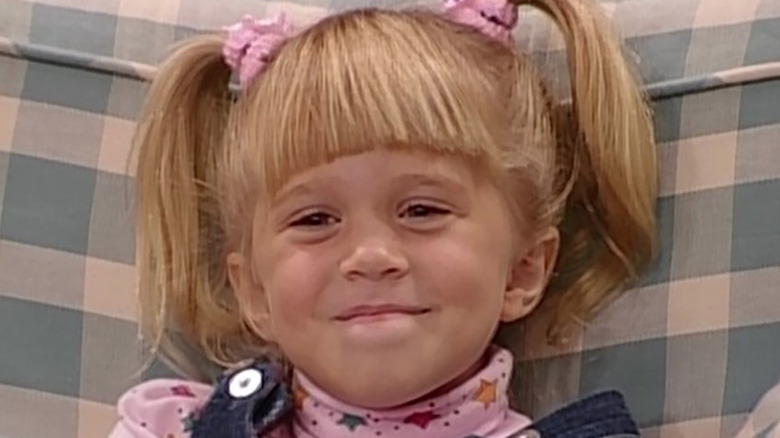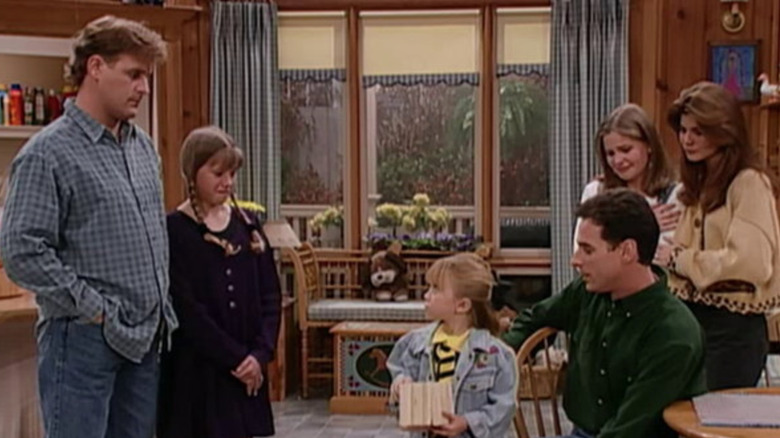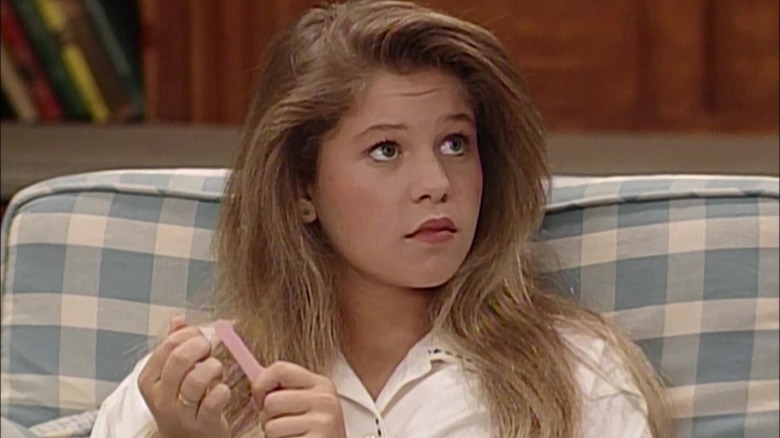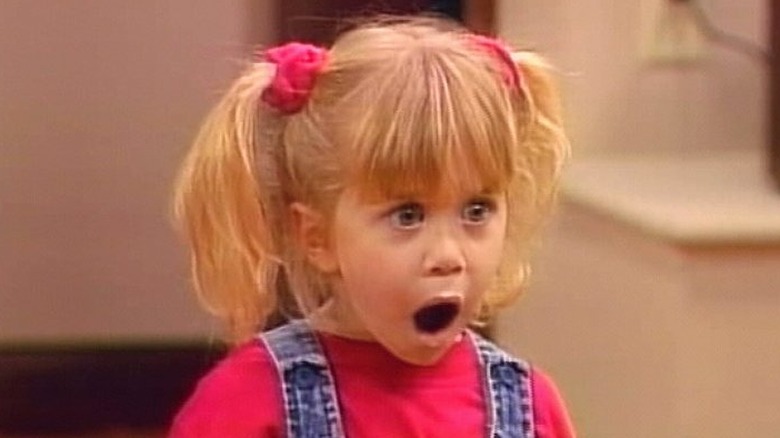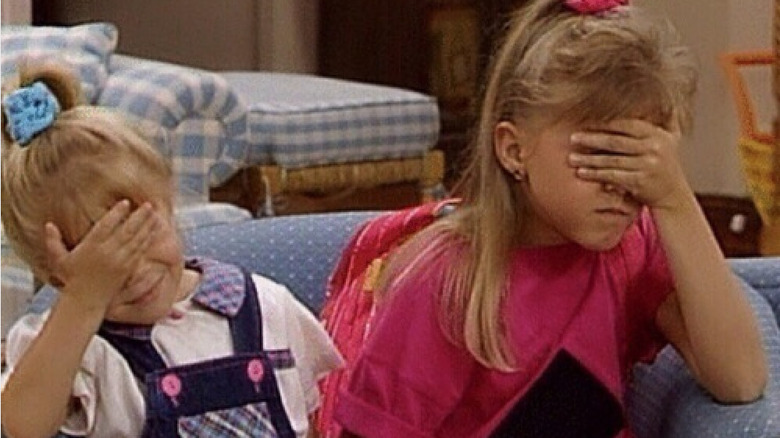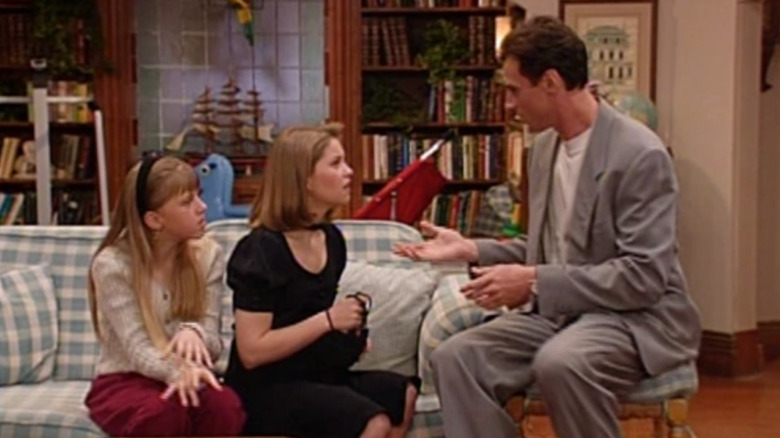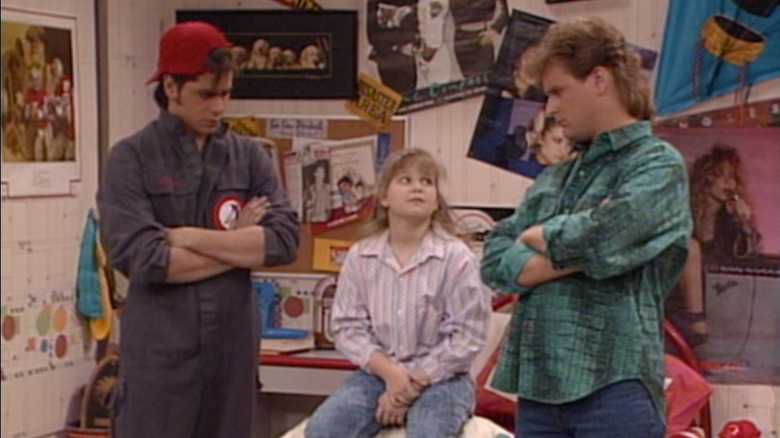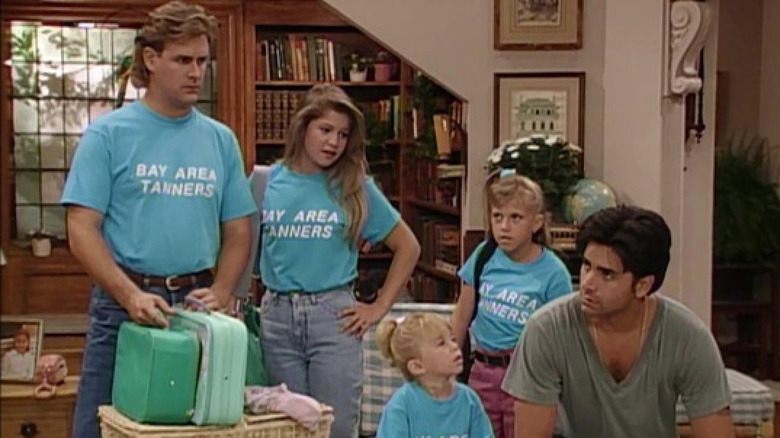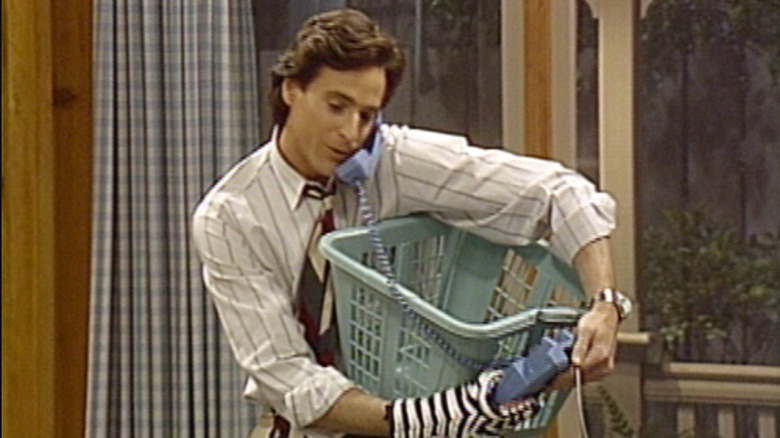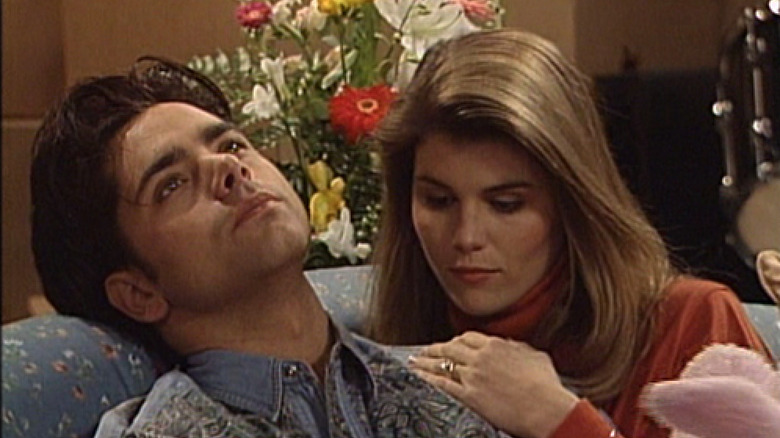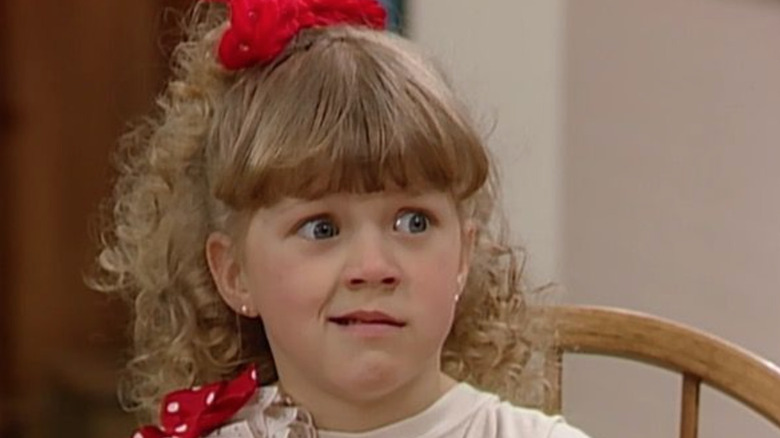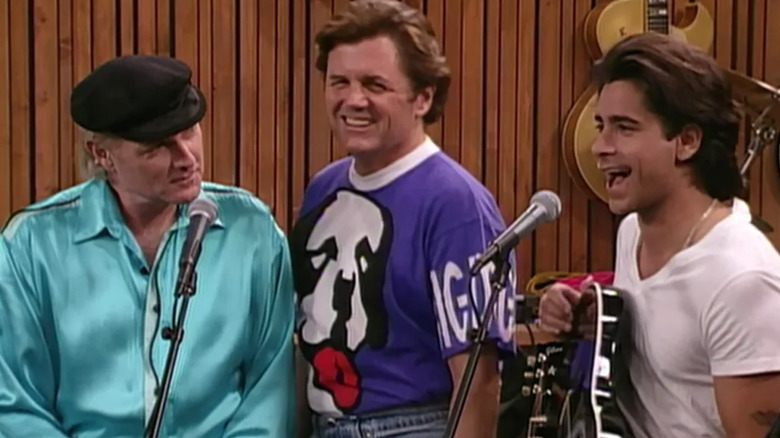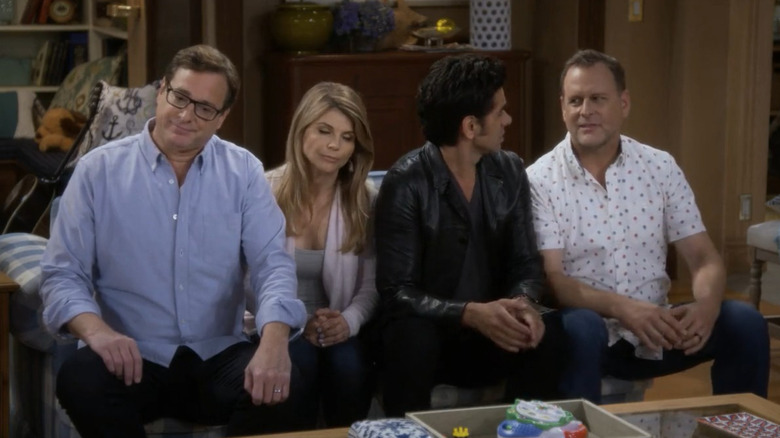The 6 Best And 6 Worst Things About Full House
Not many would agree to move into their widowed best friend's or brother-in-law's already crammed house to help raise three little girls, but that's the beauty of the '80s and '90s family sitcom "Full House." Despite resting on a pretty outlandish premise, the series was full of wholesome, light-hearted moments that earned a dedicated and continually growing fanbase. Viewers found a family in the makeshift Tanner household, and while the show was filmed at the Lorimar Studios in Los Angeles (now known as the Warner Bros. Television Studios), the classic living room set can feel like a second home.
Created by Jeff Franklin, the show ran from 1987 to 1995 on ABC, with a total of 192 episodes over eight seasons. Despite its enduring popularity, scathing reviews contributed to its rocky beginnings (via MTV News). As the show continued, it quickly proved the nay-sayers wrong and has since turned into an international hit. It only made sense to revive the show during the nostalgia boom of reboots with Netflix's "Fuller House." Still, we don't need an entirely new show to enjoy our walk down memory lane. Instead, let's look back at the six best and six worst things about "Full House."
Best: Perfect casting
It seems impossible to imagine anyone else playing the extended Tanner family. Only Jodie Sweetin could give Stephanie Tanner her comedic spunk, and no one embodies a fun-loving man-child like Dave Coulier did as Joey Gladstone. Casting can either kill a show or help skyrocket it to great success. You can have the most original, engaging premise with relatable, lovable characters, but when the casting is off, it creates a barrier that leaves viewers unable to connect.
This was almost the case with "Full House." No one else saw an issue when John Posey was cast as Danny Tanner. However, for creator Jeff Franklin, it was always between comedians Paul Reiser and Bob Saget (via Variety). Reiser chose a different dad role in the sitcom "My Two Dads" while Saget was under contract with "The Morning Program." The pilot was shot and picked up with Posey playing Danny, but the timing couldn't have been more perfect when Saget's contract ended and he became available for the role.
The rest of the casting process was just as magical. According to Variety, Franklin knew the Olsen twins made sense because "they had so much emotion and they were adorable and they had these giant big blue eyes." Coulier and Candace Cameron Bure cruised through their auditions as the roles came naturally to them. It also helped that Cameron Bure's brother Kirk Cameron was of "Growing Pains" fame. John Stamos didn't even have to audition — a lunch with Franklin was all it took. The shared on-screen chemistry is one of many things that keeps viewers coming back and new ones discovering "Full House" all these years later.
Worst: Predictable, low-stakes plot lines
"Whatever happened to predictability?" The answer lies with its overuse on "Full House," whose low-stakes plot lines almost constantly exhibited a repetitive structure. Many sitcoms fall victim to this shortcoming, and "Full House" is no exception. Often, viewers find comfort in this kind of predictability, but others find it lazy and uncreative.
If you've never seen an episode of "Full House," it's easy enough to explain just about every episode with a single breakdown. The jazzy brass instrumental plays. Fade into the opening teaser. The youngest Tanner, Michelle, is doing something cute. Cue the theme song "Everywhere You Look" by Jesse Frederick. Fade back in on the iconic Victorian-style San Francisco house. The family's problems are broken up into A and B plots. Maybe there's tension between the guys or school troubles with the girls. In the last five minutes, everyone comes together and solves their problems with a big family hug. There, now you've just seen every episode of "Full House."
Best: Memorable catchphrases and personalities
Catchphrases are a staple in classic sitcoms. They're imprinted on our brains and sneak their way into our everyday vocabulary. All the best characters have one. There's Joey Tribbiani's "How you doin'?", Steve Urkel's "Did I do that?", or Arnold Jackson's "Whatchu talkin' 'bout Willis?" Everyone has a favorite. "Full House" has some of the best catchphrases on television — some of which the actors will never be able to escape, whether it's an interview or a run-in with a fan.
Each character's catchphrase and personality go hand in hand. As a wannabe standup and serial impressionist, Danny's best friend and the Tanner girls' honorary uncle Joey Gladstone is known for his comedic bits, including his signature "Cut it out." The light-hearted phrase is accompanied by hand gestures, adding to the physical comedy of it all. John Stamos got his catchphrase for the rockstar and Elvis fanatic uncle Jesse from the Roy Orbison catcalling anthem, "Oh, Pretty Woman." For instance, the catchphrase "Have mercy" comes from the lyrics, "No one could look as good as you, mercy" (via Insider).
Then there's the sassy middle-child Stephanie, who delivers her catchphrase "How rude!" with enough verve to make Shirley Temple shake in her boots. Finally, it's only natural for little Michelle to develop her own handful of catchphrases while growing up in the "Full House" household. "You're in big trouble, mister!" and "You got it, dude!" are both memorable for their funny and adorable qualities.
Worst: Lack of diversity
While "Full House" may have its heart in the right place, its lack of diversity leaves a big chunk of viewers underrepresented. It's easy to brush off this apparent flaw as a product of its time. Zoomers may disagree, but the '90s weren't all that long ago. The main focus being on an all-white heterosexual cisgender family isn't inherently the issue. Rather, it's how "Full House" chooses to ignore any discriminatory issues when the show is known for its notable life lessons and how it tackles the subject matter when it does arises.
For example, the potentially offensive episode "Fraternity Reunion" centers around Danny and Joey's cross-dressing scheme to get their old fraternity's stolen mascot back. Comedy has seen its fair share of men in drag as the punchline, leaving some in the LGBTQ+ community feeling targeted. The policing of comedy has become more of a hot topic as society attempts to progress and take accountability, but it isn't that jokes like these can't be funny. Instead, if "Full House" directed the punchline more towards Danny and Joey rather than the absurdity of men in dresses, then maybe viewers would've had less of an issue with this particular episode.
Sadly, the revival "Fuller House" isn't much better, with one viewer calling out its blatant cultural appropriation in the Season 1 episode "Partnerships in the Night" (via MTV News). A great example of how the line "a product of its time" doesn't really work as an excuse.
Best: Valuable life lessons
Anyone coming of age with "Full House" on their screens could look to the sitcom for good examples of what to do and what not to do in relatable life situations. Watching the three Tanner sisters grow up over the course of eight years has taught viewers lessons about self-confidence, bullying, peer pressure, and dating, among other things. It isn't a "Full House" episode without sappy music playing over a heartfelt ending where everyone recounts lessons learned and hugs it out.
There's a lesson for every age group. Parents and toddlers can learn a thing or two about sharing during Michelle's selfish playdate in the Season 3 episode "Breaking Up Is Hard to Do (in 22 Minutes)." In the very next episode, titled "Nerd for a Day," Stephanie teaches young kids how to stand up to bullies. Jump forward to the Season 4 episode "Shape Up," where D.J. spreads the universal message of loving yourself for who you are.
While the seriousness of each life lesson varies by episode — from Stephanie saying goodbye to her stuffed Mr. Bear to Michelle coming to terms with the absence of her mother — "Full House" always tries to use its influence for good.
Worst: Too much pressure on the girls
Danny may be sensitive and sweet, but when it comes to his daughters, he isn't afraid to get strict. Even the "cool" dads, Jesse and Joey, know when to hammer down the law. Still, sometimes it feels like their reprimands aren't all that necessary. For example, in the Season 6 episode "Lovers and Other Tanners," Danny gets a little too uncomfortable with D.J.'s relationship with her boyfriend Steve and forbids her from ever seeing him again. Not exactly the best parenting style, but we all slip up every now and again.
That wasn't the first time D.J. had felt the pressure from her parents. In the Season 3 episode "Just Say No Way," D.J. tries to stop a group of kids from drinking at a school dance when Jesse catches her with a bottle in hand and smelling like alcohol. A classic case of "it's not what it looks like." Even when she tries to do the right thing, she still gets punished for it. Thankfully, everything's cleared up in the end and all is forgiven.
Stephanie isn't immune to the harsh pressures either. In the Season 8 episode "Making Out Is Hard to Do," Stephanie goes to Gia's house for a party, only to discover it's a makeout party she's unprepared for. She calls her dad to come to pick her up, and instead of him being grateful for her good judgment, he punishes her with a grounding. Let's hope she doesn't remember that for the next time she's stuck in a troubling situation.
Best: Challenging the status quo
Family-based television often reflects and influences the way society believes a family should look and behave. "Full House" pushed the boundaries when it came to showcasing a different kind of family. Back in the 1950s, shows like "Leave it to Beaver," "Father Knows Best," and "The Donna Reed Show" were the norm. The families being depicted were patriarchal units with parents taking on the traditional roles of breadwinning husband and a stay-at-home wife. By the 1960s, new families were popping up on our screens. "The Andy Griffith Show" and "My Three Sons" deviated ever so slightly by featuring single parents.
When "Full House" aired in 1987, the conversation around parental roles and even same-gender parenting started gaining traction. While we would still have a long way to go for LGBTQ+ representation, the three men featured in the series embraced their untraditional roles as fully-capable parents. Danny is both a neat-freak, emotional hugger, and completely secure in his masculinity, proving that certain behaviors aren't mutually exclusive with certain genders. The same can be said for Joey. The childish jokester knows when it's time to get serious and set a good example for the kids he's agreed to help raise. Then there's the macho uncle Jesse, whose soft spot for the girls is both endearing and transcendent. Nothing made Saget more proud of his character than when people expressed: "You were the dad I didn't have" (via Time).
Worst: Mocking mental illness
Besides being a supportive and understanding father, Danny's most notable character trait is his obsession with cleanliness. While the show never explicitly states a diagnosis for Danny, some of his actions mimic obsessive-compulsive disorder symptoms. He always needs everything to be in the right place, perfectly cleaned, and if it isn't, it causes him severe distress. A case of "it's not that deep" or using a mental illness for laughs? Either way, it wasn't very nice of all his loved ones to constantly berate him for an otherwise harmless and extremely helpful habit. Out of all the Tanners, Danny deserved better.
Then there was the Season 6 episode "Grand Gift Auto," where Joey accidentally buys D.J. a stolen car. When the police get involved, everyone pretends Joey is a high-functioning, mentally handicapped person to avoid facing consequences. Classy.
Luckily, we've come a long way since then, with more discussions surrounding mental health. So much so that even actress Andrea Barber, who plays neighbor Kimmy Gibbler, has since come out about her personal struggles with anxiety during the filming of "Full House" and how far she's come since then (via USA Today). That said, don't expect anything revolutionary regarding mental health in "Fuller House." One step at a time.
Best: Very special episodes
According to Dictionary.com, a very special episode is "an episode of a television series that deals with a serious issue, usually something controversial or socially difficult to talk about." The trope rose to prominence in the 1980s with episodes like "The Bicycle Man" from "Diff'rent Strokes," which deals with a child predator, and the "Mr. Belvedere" episode "Wesley's Friend," which challenged preconceived notions about the HIV/AIDS epidemic.
"Full House" wasn't afraid to hop on the bandwagon and tackle its own serious issues. Some episodes include the Season 8 episode "Under The Influence," which hammers down on the seriousness of drunk driving when Kimmy tries to drive home drunk after a party. Seeing as a drunk driver killed her mother, D.J. stands up to her friend, helping her see some sense in her actions.
In the Season 6 episode "Silence Is Not Golden," Stephanie learns her classmate is being abused by his father but makes a promise not to tell anyone. However, Stephanie learns it's better to get a trusted adult involved when it comes to issues as serious as child abuse. Very special episodes like these were handled with care and compassion and helped make these taboo subjects more approachable.
Worst: The laugh track
A sigh of relief is in order for how TV sitcoms have grown out of their laugh track phase — for the most part. However, now when you rewatch episodes of "Full House," the eruptions of laughter can be all the more jarring. Of course, part of the show's magic comes from being performed in front of a live studio audience. This was common for sitcoms from the same era, but many can't help but feel that the addition of the audience's reaction cheapens the show.
If anything, it makes the viewer feel a little dumb. There's no need to hold the viewer's hand and tell them when to laugh at something that's meant to be funny. Enough with the awkward pauses left to be filled with laughter. Unfortunately, laugh tracks haven't completely disappeared, with more modern sitcoms like "The Big Bang Theory" and "Fuller House" continuing the tradition.
Best: Nostalgic guest stars and cameos
From Doris Roberts to Vanna White, "Full House" had many memorable guest stars and cameos throughout its eight-season run. Some celebrities played themselves while others took on character roles. Either way, most of them will give you a sense of nostalgia for the '80s and '90s. Joey had a run-in with comedian Phyllis Diller during his potential big break in the Season 1 episode "But Seriously, Folks." Jesse shoots hoops with NBA star Kareem Abdul-Jabbar in the Season 8 episode "Air Jesse." Then there was the ABC TGIF crossover between "Full House" and "Family Matters," where Jaleel White made an appearance as the iconic character Steve Urkel. However, the musicians featured on the show were some of the most celebrated, with Little Richard playing the uncle of Michelle's Denise — not to mention The Beach Boys' recurring visits.
On The Howard Stern Show, Stamos talks about his lifelong love for The Beach Boys. After getting to know the guitar player and playing as the drummer for a few of their live shows, Stamos brought them on "Full House" to help promote their music. Their first appearance occurs in the Season 2 episode "Beach Boy Bingo," when D.J. wins two tickets to their concert after entering a radio contest. The Beach Boys then show up at the Tanner household and invite the whole family to come along. They sing their songs "Surfin' Safari," "Kokomo," "Barbara Ann," and "Fun, Fun, Fun." They return again in Season 3 and Season 5. It's incredible how many celebrity encounters one family living in San Francisco can have!
Worst: Fuller House revival
No one asked for a revival, and yet, it was inevitable. In fact, creator Jeff Franklin has been plotting this since the cancelation of "Full House" despite leaving the original show after five seasons. Franklin explained to Variety that "despite the enduring success of 'Full House,' no one stepped up to buy the show. It was puzzling and disappointing." Not exactly a puzzling decision from where viewers sit. The nostalgia and brand recognition are there, but unfortunately, those aren't the only two things it takes to make a watchable show. Take "Full House," flip the genders and make the jokes more cheesy, and you've created "Fuller House." It's the exact same show, but many critics found it worse in many ways. "It feels like just leaving the TV on as rerun after rerun piles up. The laugh lines are predictable. The gags play out exactly as you'd expect," reports Vox.
Still, let's not forget that "Full House" had its fair share of bad reviews when it first premiered. Described as "a great argument for birth control" by the Los Angeles Times and "one predictable situation following another" by The New York Times, "Fuller House" seems to follow in the footsteps of its predecessor — except it's unlikely to establish the legacy that "Full House" did. Give thanks to Franklin for this monstrosity of a reboot, who has since been fired from the show for allegedly creating a toxic workplace (via Vanity Fair). As if it couldn't get any worse.
